Durable Wetsuits for Kiteboarding: Top Picks
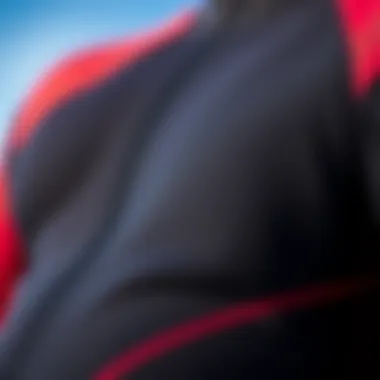
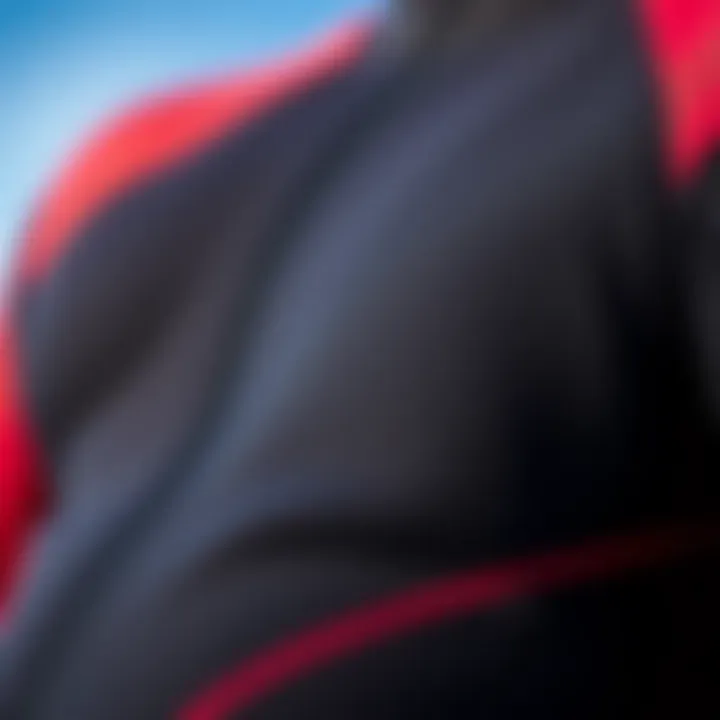
Intro
Kiteboarding, with its thrilling mix of surfing and flying, attracts many enthusiasts, each looking to carve their path across the water. However, the right gear is crucial for both performance and safety. Among these essentials, wetsuits stand out not just for their style but for the protection and comfort they provide. Understanding the durability of wetsuits can make a huge difference when choosing the right one, especially for those who frequently engage in the sport.
This article explores the intricacies of wetsuit durability. By dissecting materials, construction techniques, and maintenance practices, we equip kiteboarders with the knowledge they need to select attire that will withstand both time and tide. Not just any suit, but one that can be the reliable companion through countless adventures, be it a sunny day at the beach or the far more unpredictable winds of autumn.
In the sections that follow, we will break down essential gear, from the basics for beginners to advanced equipment for more seasoned riders. Alongside, we’ll address crucial tips and techniques, ensuring that your wetsuit not only lasts but enhances your kiteboarding experience.
Let’s dive in!
Understanding Wetsuit Durability
When it comes to kiteboarding, a durable wetsuit is nothing short of essential. Kiteboarders push their equipment to the limits, often facing harsh elements such as salt water, UV rays, and rough handling. A wetsuit that can withstand these stresses not only enhances performance but also provides peace of mind. Knowing what makes a wetsuit durable can significantly influence your comfort and longevity in the sport.
To grasp the essence of wetsuit durability, one must consider a few key elements: material composition, construction techniques, and maintenance practices. These factors contribute to the overall resilience of a wetsuit while ensuring that it serves kiteboarders well through countless rides.
Material Composition
Types of Neoprene
Neoprene is the backbone of any wetsuit. It’s a synthetic rubber that offers both thermal insulation and flexibility, which are crucial for an enjoyable kiteboarding experience. There are various types of neoprene available, like standard, limestone, and super-stretch.
Limestone neoprene, for instance, is gaining traction for its eco-friendliness and superior flexibility. It maintains a high level of compressive resistance, making it suitable for colder waters. This type of neoprene is lighter and often offers better durability compared to its petroleum-based counterparts, making it a favored choice for serious enthusiasts.
One downside is the higher cost associated with limestone neoprene, which might not fit every kiteboarder’s budget. However, considering its longer lifespan and enhanced comfort, many find it a worthy investment.
Thickness Variations
The thickness of neoprene is another fundamental aspect that influences a wetsuit's longevity. Rigid boards typically serve riders in varying conditions, requiring a suitable thickness for optimal insulation and flexibility. Thicker wetsuits, often ranging from 4/3mm to 5/4mm, provide warmth in colder waters while thinner options (like 2mm and 3/2mm) are designed for warmer climates.
While thicker options can offer superior warmth, they may limit mobility, which is essential for kiteboarding maneuvers. Hence, finding the right balance is key. Factors like water temperature and personal preference play significant roles in determining the thickness one should opt for.
Eco-Friendly Alternatives
As awareness around environmental issues grows, eco-friendly wetsuit options have started to surface. Brands are now focusing on sustainable materials and production methods that reduce environmental impact. Some of these advancements include using natural rubber, free from harmful chemicals, or even plant-based resources.
Opting for eco-friendly alternatives can benefit both the wearer and the planet. Not only do they minimize the ecological footprint, but many have also proven to perform well in the water. The only concern here is the varying effectiveness of insulation and durability compared to traditional neoprene, which may leave some skeptical.
Construction Techniques
Seam Types
Seam construction significantly affects the durability of a wetsuit. Various seam types exist, including flatlock, blind stitch, and taped seams. Each has its pros and cons. For example, blind-stitched seams create a barrier against water ingress, essential for staying warm in cooler conditions.
However, these seams tend to be pricier and require a higher skill level in manufacturing, which can impact availability.
Stitching vs. Gluing
Another critical factor is whether the seams are stitched or glued. Stitched seams offer greater strength but can allow water to seep in if not done correctly. On the flip side, glued seams are typically waterproof and provide better insulation; however, they may be less sturdy.
The choice of stitching versus gluing often boils down to personal preference and riding conditions. If you're in something more demanding with a lot of movement, find a balance that suits your needs.
Reinforced Areas
Durability also stems from how and where a wetsuit is reinforced. Areas like the knees, elbows, and shoulders typically endure more wear and tear. Thus, reinforced patches in these locations can vastly improve the lifespan of your wetsuit. These patches are often made from stronger materials to withstand constant friction and stress.
Investing in a wetsuit with reinforced areas can lead to a better experience overall. You don’t want to end up cutting your session short because of a tear or wear, especially when you're trying to enjoy a day on the water.
Understanding these nuances enables kiteboarders to choose a wetsuit that aligns not only with their performance needs but with their commitment to sustainability.
Key Features of Durable Wetsuits
When it comes to kiteboarding, having a durable wetsuit can make a world of difference. Not only does it enhance performance, but it also plays a crucial role in safety. In this section, we will delve into the key features of durable wetsuits that kiteboarding enthusiasts should consider, with a focus on flexibility, comfort, and resistance to wear and tear.
Flexibility and Comfort
Flexibility and comfort stand at the forefront when selecting a wetsuit. A wetsuit that allows for free movement is essential for kiteboarding, where every twist and turn counts.
Fit and Sizing
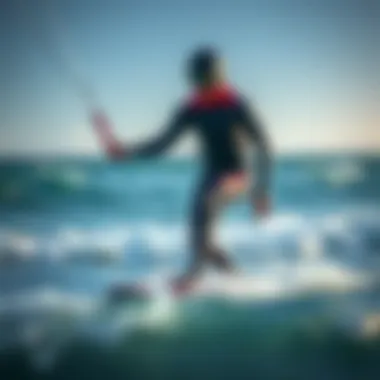
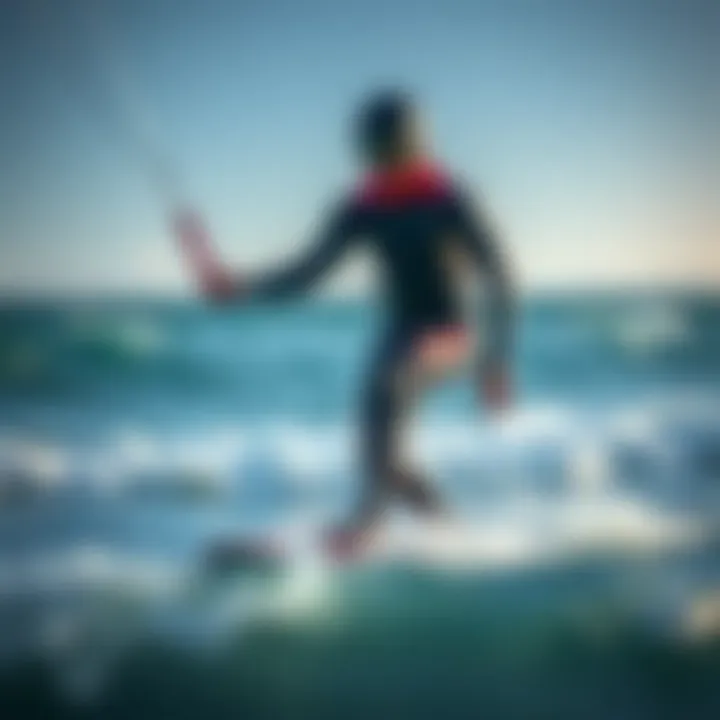
The fit and sizing of a wetsuit dictate how well it conforms to your body. A snug fit ensures minimal water entry while allowing maximum mobility. Many wearers often recommend going a size down for that perfect snugness which translates to better insulation and aerodynamics. While a wetsuit that fits like a glove can feel ideal, over-squeezing can restrict movement and create irritation during kitesurfing.
Moreover, a well-fitted wetsuit reduces drag, allowing kiteboarders to perform more efficiently in the water. When searching for that perfect fit, remember to pay attention to torso length as well as arm and leg lengths. This can make all the difference in performance and comfort.
Mobility Enhancements
Mobility enhancements are a key consideration in the design of high-quality wetsuits. Features like articulating knee panels and stretch zones around shoulder areas are engineered to facilitate a greater range of motion, which is particularly beneficial during intense maneuvers.
One popular trend in wetsuit design is the incorporation of super-stretch materials, which significantly increase flexibility. This enhancement ensures that kiteboarders can bend and twist without restriction, leading to improved control over the kite. However, it's worth noting that while these advanced materials provide excellent mobility, they might compromise some insulation properties, making it crucial to find a balance.
Temperature Control
Temperature control cannot be overlooked, as it directly influences comfort during long sessions on the water. High-quality wetsuits often utilize thermal lining and advanced insulating technology to help maintain body heat.
A remarkable feature found in many durable wetsuits is the use of materials designed to trap a thin layer of water between the skin and wetsuit, which then warms up from body heat, contributing to overall warmth.
However, an overly insulated wetsuit may lead to overheating in warmer waters. Thus, it’s essential to choose a wetsuit that matches the specific conditions you will face while kiteboarding, ensuring optimal thermal regulation throughout your ride.
Resistance to Wear and Tear
Resistance to wear and tear is another pillar that supports the longevity of your wetsuit. Given that kiteboarding often involves exposure to harsh conditions, this attribute is vital to protect your investment.
UV Resistance
One significant aspect of durability is UV resistance. Wetsuits designed with UV protection can withstand prolonged exposure to sunlight without degrading. This protection is crucial for kiteboarders who spend hours on the water under direct sunlight.
Wetsuits made with UV-resistant materials can maintain their color and structural integrity better than those without such properties. While it might not seem like a big deal initially, prolonged sun exposure can lead to fading and material breakdown. So, if you’re planning on long days of kiteboarding, opting for a wetsuit with good UV resistance is a wise choice.
Acid and Saltwater Resistance
Practically, resistance to acid and saltwater is non-negotiable for durability. The ocean’s saltwater and certain water sports environments can wear down materials over time. Wetsuits crafted with specific materials that resist these elements hold up much better against degradation.
This feature not only extends the lifespan of the wetsuit but also preserves the fit and flexibility essential for performance. Using a wetsuit that can withstand nature’s harsher aspects can cost a bit more upfront, but it saves in the long haul.
Lifetime Expectations
Finally, understanding lifetime expectations is crucial for making an informed purchase. On average, a good-quality wetsuit can last anywhere from two to five years depending on usage and care. However, some high-end models equipped with the latest technology may last longer with proper maintenance.
If you engage in frequent kiteboarding or harsh environments, investing in a durable model is particularly beneficial, as it will withstand the test of time better than cheaper options. That said, regularly checking for wear and tear, like seam integrity, can help extend the lifespan of any wetsuit, ensuring that you get your money’s worth.
In summary, when choosing a wetsuit for kiteboarding, recognizing essential features is key to finding the right balance between functionality and durability. Flexibility, comfort, and resistance to wear are not just nice-to-haves; they are central to your performance and enjoyment on the water.
Top Brands Renowned for Durability
When it comes to kiteboarding, selecting a durable wetsuit can make all the difference between a good day on the water and a soggy disappointment. Durability in a wetsuit isn't just about withstanding the harsh elements; it also involves comfort, fit, and performance. Therefore, knowing which brands deliver reliable and long-lasting products is essential. This section dives into some of the most reputable brands that kiteboarders trust for their durability.
Industry Leaders
Brand A Overview
Brand A has carved a niche in the market with its impressive line of wetsuits designed specifically for extreme sports enthusiasts. What sets Brand A apart is its commitment to using high-quality materials that ensure durability without compromising flexibility. Their wetsuits often feature a unique blend of neoprene that enhances thermal insulation while keeping the weight low.
One standout characteristic is their meticulous seam construction that guarantees a watertight fit even under the most strenuous conditions. Wetsuits from Brand A are a popular choice among kiteboarders because they provide good mobility and maintain shape over time. A notable downside, however, is the price point, which tends to be on the higher end, but many users say the investment pays off in longevity.
Brand B Overview
Brand B, another prominent name, emphasizes innovation and functionality in its products. Known for pioneering several technological advancements, Brand B's wetsuits incorporate features like quick-drying fabric and built-in UV protection which is crucial for lengthy kiteboarding sessions. Their wetsuits aren't just about keeping warm; they promote ease of movement which kiteboarders value highly.
A key highlight of Brand B is their range of thickness options, allowing users to choose the right level of insulation for their specific environments. While the offerings are generally well-received, some users might find that an overly tight fit can affect comfort after extended use. Overall, Brand B remains a favorite for adventurers who seek versatile, resilient gear.
Brand Overview
Brand C is well-regarded for its sustainability efforts while maintaining a steadfast focus on durability. With an increasing eco-conscious market, Brand C utilizes eco-friendly materials that not only stand the test of time but also reduce environmental impact. Their wetsuits are always made with meticulous craftsmanship, ensuring that durability isn't sacrificed for ethical considerations.
Features like reinforced padding in high-wear areas make Brand C's wetsuits a reliable option for kiteboarders who often snag their gear on rough surfaces. On the flip side, while their innovative materials are compelling, they may not cater to every budget. Yet, for those who are conscious about both performance and the planet, this brand emerges as a top contender.
Innovative Up-and-Comers
Brand Overview
Brand D is the kind of brand that urban explorers and coastal thrill-seekers are starting to notice. Their wetsuits are designed with the newest technologies in mind, providing a lightweight feel without skimping on warmth. Their unique feature is the seamless construction, eliminating chafing and allowing for greater mobility in watersports. This is especially crucial for kiteboarding where quick movements can make or break your ride.
While they have gained a following thanks to their flexibility and comfort, some users note that the durability aspect might not be as robust as more established brands. But for those wanting a fresh, lightweight suit, Brand D has become a go-to choice.
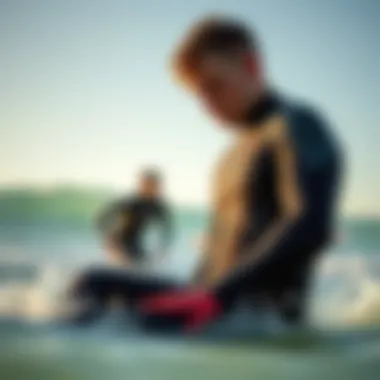
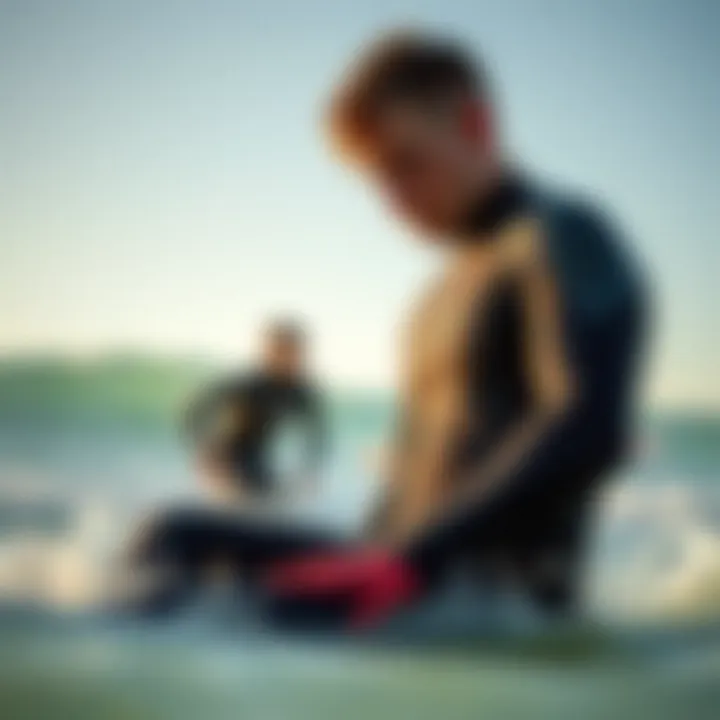
Brand E Overview
On the other hand, Brand E brings a fresh perspective to the traditional wetsuit arena. Their unique selling proposition revolves around customizable fit options, where you can tailor the wetsuit to exactly your body shape. This is a game-changer for kiteboarders plagued by ill-fitting gear.
One major advantage that users have pointed out is the enhanced thermal regulation system integrated into their products, making them a suitable choice for varying water temperatures. However, customization typically comes at a cost, and some kiteboarders may find themselves facing a longer wait time for their ideal fit. This brand’s innovation and focus on individual needs create quite an appeal.
Brand F Overview
Lastly, Brand F has been garnering attention in niche circles for its creative use of smart fabrics that respond to body temperature, ensuring optimal comfort levels. This brand is an exciting newcomer not just for the avid kiteboarder, but also for anyone keen on maximizing their performance through advanced gear.
Their wetsuits commonly come equipped with a neat feature that adjusts insulation based on the external temperature and the wearer’s activity level. While they boast this exciting technology, some users have reported that the reliance on smart tech might make the suits slightly more fragile than traditional options. For those interested in the intersection of technology and water sports, Brand F is a brand worth looking into.
Wetsuit Care and Maintenance
Caring for and maintaining your wetsuit can make all the difference in its lifespan and performance. Just like a good pair of kiteboarding fins needs attention, so does your wetsuit. With proper care, you can squeeze out every last drop of value from your investment. This section dives into crucial aspects of cleaning and storing your wetsuit, ensuring way more than just a functional piece of equipment—it becomes a reliable companion in your adventures.
Cleaning Practices
Rinsing After Use
One of the simplest yet most vital steps in your wetsuit care routine is rinsing it after each use. When you come out from the saltwater or a lagoon, soaked in sea elements, the last thing you want is to let the residues settle into your suit’s fabric. Rinsing helps wash away salt crystals, sand, and other debris that could wear down the material over time.
Key characteristic? It’s quick and easy. Just a thorough hose down…
- Benefits for the wetsuit: This practice extends the life of your suit. Without regular rinsing, debris can cause abrasion, reducing flexibility and leading to premature wear.
- Disadvantages: One might argue that getting cold water on a hot day feels unnecessary. But embracing this routine aligns with optimal wetsuit maintenance, keeping it comfy and performing at its best for longer.
Recommended Cleaners
While plain water does a decent job, you might want to consider the occasional use of specialized wetsuit cleaner. These soaps are gentle on the neoprene, helping eliminate odors and keeping the jacket fresh.
Why choose a specific wetsuit cleaner?
- Key characteristic: They avoid the harsh chemicals found in regular detergents, which can degrade the suit’s quality over time.
- Unique feature: Many are biodegradable, aligning with eco-friendly practices.
- Advantages: Your suit smells better over time while maintaining flexibility.
- Disadvantages: Cleaning might require a bit of an investment, but compared to the cost of replacement, it’s a sound approach in the long run.
Drying Techniques
Drying your wetsuit correctly is just as important as cleaning it. Hanging it up without proper care can lead to unwanted stretching or misshaping.
Here’s a good practice: always dry your wetsuit inside out in a shaded area. This way, you ease the tension on the fabric while ensuring that the outside (which could get crusty over time) doesn’t sun bleach.
- Key characteristic: Air-drying avoids heat, which can warp the material.
- Advantages: Preserves the wetsuit’s longevity; you wouldn’t want a shortened lifespan from a little impatience!
- Disadvantages: It requires some time, but it’s minimal effort for the life of your suit.
Storage Tips
Keeping it Shape
Your wetsuit isn’t just a rubbery garment; it’s engineered for peak performance. Proper storage is imperative to maintain its shape. Avoid folding your suit; rolling it up gently or hanging it can be optimal.
- Key characteristic: Maintains the suit structure and prevents creases that could weaken material integrity over time.
- Benefits: When you take your suit out for your next session, it’ll fit just as it should, enhancing your comfort and performance.
- Disadvantages: Vertical space might be a concern, but a little ingenuity with hangers comes into play.
Temperature Considerations
The environment where you store your wetsuit can dramatically affect its longevity. Extreme heat or direct sunlight can break down the neoprene faster than you can say “kiteboarding.”
- Key characteristic: A cool, dry place ensures stability for your suit.
- Benefits: Reduces wear and tear, allowing you more uses without needing early replacements.
- Disadvantages: Some might have limited storage options, but a little creativity might just do the trick.
Long-Term Storage Advice
If you're not heading out to the waves for a while, knowing how to store your wetsuit becomes let's say, fundamental.
- Key characteristic: For extended storage, rinse properly and ensure it’s completely dry.
- Benefits: Prevents mildew or foul smells from forming.
- Disadvantages: If not stored properly, you risk pulling out an unpleasantly smelly suit next time. Who would want that?
In summary, taking proper care to clean and store your wetsuit is like giving it a little insurance against the elements that can wear it down. Each step of maintenance helps keep your gear in shape and ready for action. With these strategies in your kit, your wetsuit can be a steadfast partner for many seasons of kiteboarding adventures.
Making the Right Choice
Choosing the right wetsuit is pivotal for kiteboarders. A wetsuit isn’t just a piece of gear; it’s essential armor against the elements. Poor choices can lead to discomfort and hinder performance. Understanding your own needs and preferences ensures better experiences on the water. Therefore, making an informed decision can save not only money but also a lot of hassle down the line.
Assessing Personal Needs
Skill Level Considerations


When it comes to skill level, a beginner kiteboarder might need a different suit than an expert. Beginners often prioritize ease of movement and warmth, while seasoned pros may look for suits that enhance their maneuverability. A beginner-friendly wetsuit likely has a looser fit, thus allowing more comfort during learning. In contrast, advanced models offer tighter fits and specialized features for greater performance. The unique feature of a beginner-friendly suit is its versatility in varying conditions, providing the needed warmth without compromising comfort. However, opting for a suit tailored for higher skill levels too soon could be a disservice, as it might inhibit their learning curve.
Environmental Factors
Environmental factors play a crucial role in the decision-making process. Depending on the water temperature and climate, kiteboarders should select wetsuits designed for specific conditions. For instance, warmer waters usually call for thinner suits, while chillier spots require thicker insulation. This attention to local conditions can greatly improve the experience; it’s akin to wearing the right shoes for a specific terrain. A unique aspect of choosing based on environment is the chance to incorporate eco-friendly materials, which are gaining traction among manufacturers. However, it’s essential to balance performance with environmental concerns—suits that prioritize sustainability may sometimes lack in insulation.
Budget Constraints
Everyone has a budget, and it's made of the cards you can play without breaking the bank. It’s critical to find a wetsuit that doesn’t just meet performance needs but also fits within financial constraints. While premium models often offer cutting-edge technology and materials, budget-friendly options are abundant. These suits tend to cover the basic needs without the bells and whistles of high-end gear. Prioritizing budget means understanding the unique feature of getting a reliable wetsuit without splurging on unnecessary features. However, skimping too much can lead to sacrifices in durability and performance, which may require additional costs in the long run.
Test and Review
Field Testing
Nothing beats getting out on the water to truly evaluate a wetsuit. Field testing provides first-hand experience regarding flexibility, comfort, and insulation. This practical aspect can unearth the pros and cons of different brands and models. This unique feature for field testing is that it allows kiteboarders to push their gear to the limits, observing how it performs in real conditions. While brand specifications can offer some guidance, nothing compares to real-world performance. However, it does require effort to arrange these sessions, which not everyone may have the luxury to do.
User Reviews
User reviews serve as invaluable resources for potential buyers. These insights often reveal details that marketing language can gloss over. Personal experiences shed light on durability, comfort, and real-life performance, which benefit prospective users in making informed decisions. A notable characteristic of user reviews is their variety—different kiteboarders have different experiences and preferences, offering a broad spectrum of analyses. This feature sometimes highlights downsides that may not be part of promotional materials. While it’s important to sift through feedback critically, it can dramatically shape the choice of a wetsuit.
Comparison Tools
Comparison tools can streamline the decision-making process significantly. Platforms that allow users to weigh different wetsuit options side by side save time and effort for kiteboarders seeking to make informed choices. This characteristic of comparison tools grants visibility into price differences, materials, and features at a glance. The unique aspect is that it enables potential wearers to see all relevant info in one place, aiding in educated choices. However, it can be easy to get overwhelmed by too many options and miss out on standout features suited to personal needs.
"The right wetsuit can make the difference between an exhilarating day on the water and a miserable slog."
Future Trends in Wetsuit Technology
As kiteboarding continues to evolve, the demand for wetsuits that can keep up is increasing. Kiteboarders are looking for gear that can withstand both environmental challenges and the rigors of frequent use. This section explores innovative elements in wetsuit technology that are shaping the future, enhancing overall performance while prioritizing sustainability. Understanding these trends equips enthusiasts with knowledge to choose wisely among the available options.
Emerging Materials
Smart Fabrics
Smart fabrics are gaining traction for their unique ability to integrate technology into the fabric itself. This allows for features like moisture management and temperature regulation, offering kiteboarders a layer of comfort during their rides. One of the notable characteristics of smart fabrics is their breathability, which serves to wick moisture away from the body. As such, when kiteboarders hit the waves, they don't get weighed down or chilled, enabling sustained performance. However, while this technology is beneficial, the cost may be higher than traditional materials, which is something to keep in the back of one’s mind.
Biodegradable Neoprene
Biodegradable neoprene is making some waves in the industry as a sustainable alternative to conventional neoprene. The key characteristic of biodegradable neoprene is its ability to break down over time, reducing the environmental impact associated with wetsuit disposal. As kiteboarders and outdoor enthusiasts become more environmentally conscious, opting for biodegradable options demonstrates a commitment to preserving the oceans. Though the unique feature of this material is its eco-friendliness, it is essential to note that not all brands have perfected this technology yet, leading to variability in quality.
Carbon Neutral Production
Carbon neutral production methods focus on reducing greenhouse gas emissions during the manufacturing process. It's a vital consideration for today’s environmentally aware consumer. The key aspect of carbon neutral production is the use of renewable energy sources and offsetting any unavoidable emissions. Brands adopting this approach signal their commitment to sustainability, appealing to kiteboarders who value ecological responsibility. However, the challenge lies in maintaining high-quality standards while pursuing these production methods. It’s a balancing act that not all companies have mastered yet.
Design Innovations
3D Printing Applications
3D printing is changing the game in wetsuit manufacturing. This technology allows for rapid prototyping and customization that could mean a perfect fit for kiteboarders. One of the standout benefits here is the potential for intricate designs that traditional manufacturing can't achieve. This specificity can enhance movement and performance in the water. Nevertheless, the durability of 3D printed components remains an ongoing concern, as longer-term tests are required to see how these materials stand the test of time.
Custom Fit Solutions
Custom fit solutions are becoming more mainstream, addressing the tedious process of finding the perfect wetsuit. With advanced measuring technologies, these solutions use data to craft wetsuits that hug every curve of the body, ensuring maximum comfort and functionality. The unique feature of this approach is the tailored experience, which can significantly enhance performance on the water. However, while custom fits can provide superior comfort, the price point may increase, making it less accessible for casual kiteboarders.
Sustainability Efforts
In recent years, there has been a noticeable shift toward sustainability efforts across the wetsuit industry. Brands are exploring alternative materials and eco-friendly production methods, indicating that they are listening to the concerns of environmentalists. A key aspect here is the transparency of the supply chain, allowing consumers to make informed purchasing decisions. The advantage of these efforts is the reduced carbon footprint of wetsuit production, which benefits all water sports enthusiasts. Yet, the challenge remains in ensuring these sustainable materials can match or exceed the performance of traditional wetsuits.
"Innovation is key in the wetsuit industry, as it paves the way for more sustainable options without compromising performance."
Closure
In the pursuit of kiteboarding, selecting the right wetsuit isn’t just about comfort or style; it’s about ensuring longevity and resilience against the elements. The analysis of durability discussed throughout this article underscores crucial aspects such as material quality, design innovations, and proper maintenance. These elements not only enhance the lifespan of a wetsuit but also directly impact the performance and experience of kiteboarders.
Investing in a durable wetsuit can seem daunting, with various brands and features complicating the decision-making process. However, the benefits of robust gear far outweigh the initial costs. A well-constructed wetsuit can withstand frequent exposure to harsh saltwater and UV rays, ensuring that your activities remain uninterrupted by wear and tear. Moreover, as we delve deeper into the specifics of maintenance and care, it becomes evident that the right practices can significantly enhance the durability of any wetsuit.
Ultimately, the journey does not stop at purchasing a wetsuit. Understanding the importance of the right gear's durability is essential for kiteboarders who wish to enjoy their sport fully. The insights provided here equip enthusiasts with the knowledge needed to make informed decisions, ensuring their gear not only meets their immediate needs but also serves as reliable protection for years to come.
Key Takeaways
- Material Matters: Explore the various types of neoprene and their respective thicknesses to find the right fit for your needs.
- Construction Counts: Pay attention to seam types and stitching methods; reinforced areas can be a game-changer in durability.
- Care is Crucial: Regular maintenance practices, including appropriate cleaning and storage, can greatly extend the life of your wetsuit.
- Know Brands: Familiarize yourself with industry-leading and innovative brands that prioritize durability in their product line-up.
Encouragement for Research
As the landscape of wetsuit technology continues to evolve, it’s crucial for kiteboarding enthusiasts to stay informed. Engage with online communities, read product reviews, and participate in discussions on platforms like reddit.com to gather insights from fellow kiteboarders.
Take an active role in your wetsuit journey—consider personal needs, local environmental conditions, and even budget adjustments. Accumulating knowledge about the latest advancements in materials and design innovations will empower you to make choices that enhance not just your safety and comfort but the overall thrill of kiteboarding. Remember, the ocean is vast, and so are your options.



